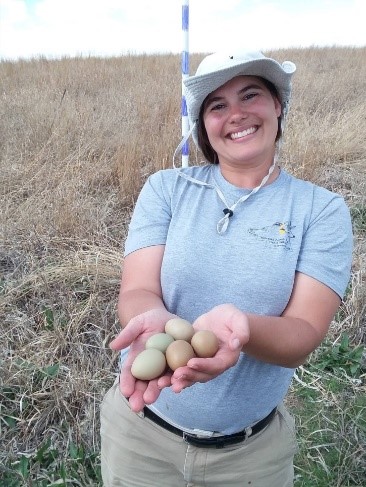Ring-necked Pheasant Survival, Nest Habitat Use, and Predator Occupancy in Kansas Spring Cover Crops
 Investigators:
Investigators:
Adela Annis, M.S. student
Project Supervisors:
Dr. David Haukos
Funding:
Kansas Department of Wildlife,
Parks and Tourism
Cooperators:
Kansas Department of Wildlife
Parks and Tourism
Location:
Graham, Norton and Russell
counties, Kansas
Completion:
August 2020
Status:
Completed
Objectives:
Determine factors influencing survival of adults, broods, and nests within cover crop and fallow crop treatments within Kansas
Assess nest-site selection of used verses available cover crop and fallow treatments
Measure predator occupancy in difference cover crop and fallow crop treatments
Progress and Results:
Ring-necked pheasants are an economically important upland gamebird within Kansas that contribute to local and state economies. Additional management techniques are being investigated to improve regional and local populations. Spring cover crops have been suggested as a possible tool for increasing habitat on the landscape during the breeding season when traditionally agricultural fields are left fallow. Spring cover crops in Kansas are planted between March and May, and then terminated in June or July prior to the planting of a cash crop, namely winter wheat. In 2017, we evaluated use of three cover crop mixes, a custom mix, commercial mix, wildlife mix and a chemical fallow control. Female pheasants were captured in proximity to the planted spring cover crops and collared with very-high-frequency (VHF) necklace style radio transmitters to estimate survival and nest selection relative to use of spring cover crops and other types of land cover. Camera traps were placed on the edge and within the treatments to determine how cover crops may influence predator occupancy. Our research findings will provide wildlife researchers with information on cover crop benefits to wildlife and additional methods for managing upland gamebird populations in Kansas.
Results from our first year of research indicate that apparent female adult survival was lowest during spring raptor migration. Nest survival during the laying and incubation period was related to age of the nest and proportion of winter wheat surrounding nests. Nesting near or within winter wheat may positively influence nest survival. In 2017, Kansas pheasant nests were located in a variety of land-use types; however 19 of the 28 nests located in fields enrolled in the Federal Conservation Reserve Program (CRP) for native grasses. Spring cover crops can reach the vegetation densities pheasants require, but after peak nesting has occurred.
Spring cover crops provided resources for other wildlife species, including predators of pheasants. Of the seven species investigated, four were most influenced by the edge of the treatments, two by cover crop treatments, and one had constant occupancy. The interior area of cover crops may be a potential refuge for pheasants from certain predator species.
Products:
Professional Presentations:
Annis, A. C., A. Godar, D. Haukos, and J. Prendergast. 2018. Effects of spring cover crops on ring-necked pheasant survival and resource selection with notes on mesocarnivore occupancy. Annual Meeting of the Central Mountains and Plains Section of The Wildlife Society, Kearney, Nebraska.
Annis, A. C., A. Godar, D. Haukos, and J. Prendergast. 2018. What drives nest-site selection of Kansas ring-necked pheasants? Kansas Natural Resources Conference, Manhattan, Kansas.
Annis, A., D. Haukos, and J. Prendergast. 2017. Mesocarnivore occupancy within Kansas spring cover crops. Kansas Ornithological Society, Junction City, Kansas.
Annis, A.C., A. Godar, D. Haukos, and J. Prendergast. 2018. Survival and nest-site selection of ring-necked pheasants in western Kansas spring cover crops. Annual Meeting of The Wildlife Society, Cleveland, Ohio.
Annis, A.C., A. Godar, D. Haukos, and J. Prendergast. 2017. Kansas ring-necked pheasant habitat use and survival in summer cover crops. Kansas Natural Resource Conference, Wichita, KS.
Annis, A.C., A. Godar, D. Haukos, and J. Prendergast. 2017. Survival of ring-necked pheasants in western Kansas spring cover crops. Annual conference of The Wildlife Society, Albuquerque, NM.